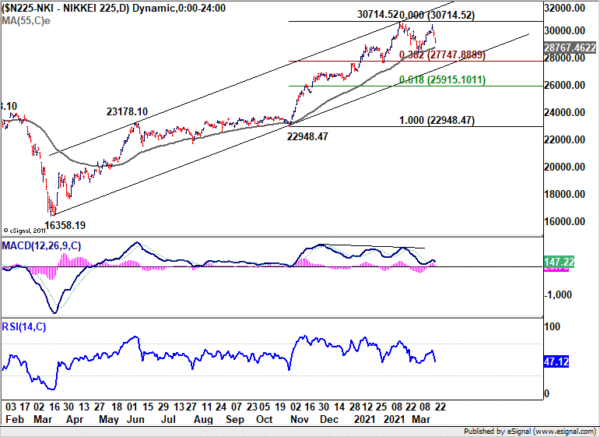The financial markets are generally mixed with subdued trading today. Nikkei did had a bad day, but the selloff didn’t spread to other markets. European indices and US futures are mixed while Germany and US benchmark yields are mildly lower. As for currencies, Aussie and Sterling are currently the softer ones, followed by Dollar. Swiss Franc and Euro are the stronger ones, followed by Canadian. There isn’t a very clear direction for now.
Technically, as Euro is attempting a rally, eyes will be of its crosses. The levels to note include 1.1989 minor resistance in EUR/USD, 0.8638 minor resistance in EUR/GBP and 130.65 temporary top in EUR/JPY. As long as these levels holds, we’d treat current rebound in Euro as part of the near term corrective moves only.
In Europe, currently, FTSE is up 0.15%. DAX is up 0.17%. CAC is down -0.32%. Germany 10-year yield is down -0.010 at -0.301. Earlier in Asia, Nikkei dropped -2.07%. Hong Kong HSI dropped -0.36%. China Shanghai SSE rose 1.14%. Singapore Strait Times dropped -0.21%. Japan 10-year JGB yield dropped -0.0338 to 0.082.
Knot: ECB frontloads asset purchases as counterweight to yield rise
ECB Governing Council member Klass Knot said that a “major part” of recent rise in Eurozone treasury yields was due to improvement growth in inflation outlook of the bloc. But still, the rest was an unwarranted response to the surge in US yields.
Hence, “we thought it would be wise to frontload part of our purchases, as a counterweight in the coming months”. Knot referred to ECB’s decision to significantly increase the pace of the pandemic emergency purchase program in Q2.
“But as soon as the improvements that we expect materialise, that reason of course will disappear,” he added.
Bundesbank: output to decline sharply in Q1, but industry benefited from foreign demand
Germany’s Bundesbank said that economic output is likely to “decline sharply” in Q1, in particular in contact-intensive service sectors. In addition to the pandemic containment measures, the higher VAT rates since the beginning of the year also played a role in the contraction.
Nevertheless, industry benefited from “dynamic foreign demand”. Incoming orders “significantly exceeded” pre-crisis level of Q4 2019. Good exports continued to grow, with “sharp rise in exports to other countries” more than enough to compensate the loss of exports to UK.
Bundesbank also noted the “significant increase” in consumer price”. One reason is rise in energy prices. Others include some food prices.
BoJ Kuroda said not considering selling ETF holdings, nor halting purchases
BoJ Governor Haruhiko Kuroda told upper house financial committee that wit the review of ETF purchases, the central bank could continue to use easing policy “more flexibly and effectively.” ETF purchases are also a vital part of the yield curve control, which will guide YCC to avoid impact of stock prices. Currently, the central bank is not considering selling ETF holdings at all, nor halting purchases.
Additionally, Kuroda also emphasized the need to maintain the 2% inflation target. He said that it’s a “global standard” and “must not change”. The inflation target also helps stabilizes currencies among major economies.
Japan Nikkei dropped -2%, as corrective pattern develops the third leg
Japan’s Nikkei closed sharply lower by -2.07%, or -617.9pts, to 29174.15. Markets attribute the decline to many reasons, from the fire at semiconductor supplier Reneasas’ plant, to BoJ’s stop in purchasing Nikkei-linked ETFs, to surging US treasury yields, and even to the free fall in Turkish Lira.
But technically, the sharp fall was seen as nothing more than the third leg of the consolidation pattern from 30714.52. There wasn’t remotely enough evidence to suggest a change in the medium term up trend from 16358.19.
While deeper correction cannot be ruled out, the first line of defense will be from 55 day EMA (now at 28767.46). Sustained break of that would turn focus to channel support (now at 27170). We’d see how deep the correction would develop into.
EUR/USD Mid-Day Outlook
Daily Pivots: (S1) 1.1874; (P) 1.1905; (R1) 1.1937; More….
EUR/USD recovers mildly today but it stays in range of 1.1834/1989. Intraday bias remains neutral first. On the upside, break of 1.1989 will extend the rebound to 55 day EMA (now at 1.2032). Sustained break there e will indicate completion of correction from 1.2348 and bring retest of this high. On the downside, however, break of 1.1834 will extend the correction from 1.2348 to 38.2% retracement of 1.0635 to 1.2348 at 1.1694.
In the bigger picture, rise from 1.0635 is seen as the third leg of the pattern from 1.0339 (2017 low). Further rally could be seen to cluster resistance at 1.2555 next, (38.2% retracement of 1.6039 to 1.0339 at 1.2516). This will remain the favored case as long as 1.1602 support holds. We’d be alerted to topping sign around 1.2516/55. But sustained break there will carry long term bullish implications.
Economic Indicators Update
| GMT | Ccy | Events | Actual | Forecast | Previous | Revised |
|---|---|---|---|---|---|---|
| 09:00 | EUR | Eurozone Current Account (EUR) Jan | 30.5B | 34.5B | 36.7B | |
| 11:00 | EUR | German Buba Monthly Report | ||||
| 14:00 | USD | Existing Home Sales Feb | 6.50M | 6.69M |


 Signal2forex.com - Best Forex robots and signals
Signal2forex.com - Best Forex robots and signals




